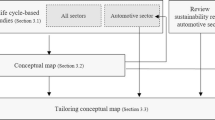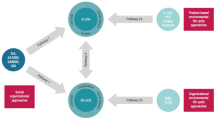Abstract
Purpose
Current product social life cycle assessment (SLCA) addresses social aspects from a life cycle perspective, but it is not yet broadly implemented in practice. We propose a new organizational perspective to boost SLCA—the social organizational LCA (SOLCA). The paper answers four guiding questions: Why do we need SOLCA? How can we apply it? How can its implementation benefit from existing experience? Which are the foreseen limitations?
Methods
First, challenges of SLCA which may be overcome by an organizational perspective are identified, and potential solutions are described. An analysis of the indicators proposed by SLCA is conducted. Second, first ideas for a conceptual framework for SOLCA are developed. The two underlying methodologies: the guidelines for SLCA of products and the guidance on organizational LCA (OLCA)—which adapts product LCA to the organizational perspective—were reviewed, compared and adapted to a social organizational perspective. Third, different implementation pathways were identified, showing how SOLCA could be applied in practice by considering different levels of organizations’ experiences with social and environmental assessments.
Results and discussion
Existing SLCA case studies do not really evaluate the social performance of products. From the 189 indicators proposed in SLCA, only eight refer to the product level, while 127 and 69 refer to the organizational and country level, respectively—including overlaps and according to the methodological sheets. This fact clearly favors an organizational approach to social LCA. SOLCA may streamline allocation, data collection, and application in practice. The conceptual framework for SOLCA is focused on scope and inventory, which were found to differ most from SLCA and OLCA; all relevant steps like definition of unit of analysis or multi-functionality are addressed. Three SOLCA implementation pathways are proposed. Existing experience of organizations in social organizational approaches —like Global Reporting Initiative (GRI) or product SLCA— and environmental approaches —like environmental management systems (EMS) or OLCA— can be used as starting points as they can provide useful information on the organization´s structure, value chain, etc.
Conclusions
SOLCA helps to overcome some major challenges of SLCA and thus is a promising approach for putting it into practice. The frameworks of SLCA and OLCA can be integrated into SOLCA, and existing experience from organizations can be used for implementing it. However, new challenges arise. This includes potential difficulties for primary data collection in complex organizations with many different sites or the difficulty to distribute or aggregate social aspects within the organization. Further development and testing of SOLCA is recommended.


Similar content being viewed by others
Notes
The two publications “Guidelines for product social life cycle assessment” (UNEP/SETAC 2009) and “Guidance on organizational life cycle assessment” (UNEP 2015) use the acronym “S-LCA” and “O-LCA”, respectively. However, according to the International Journal of Life Cycle Assessment editorial policy, the acronym used by ISO/TS 14072, without hyphen, should be used here for “OLCA” and the same policy is used for “SLCA” and “SOLCA.”
Indicators (e.g., number of working hours) are used to measure social impacts (e.g., health and safety). Usually, several different indicators are used to assess one impact category.
The eight indicators which can refer to the product level are as follows: “number of consumer complaints,” “total number of incidents of non-compliance with regulations and voluntary codes concerning health and safety impacts of products and services and type of outcomes,” “quality of or number of information/signs on product health and safety refer to the product level,” “quality of labels of health and safety requirements,” “consumer complaints regarding transparency,” “certification/label the organization obtained for the product/site,” “disputed products (labelling, etc.),” and “contribution of the product/service/ organization to economic progress."
This is the approach to be selected by the organization for setting the reporting organization. It represents the structure of the organization and its relationships with other organizations. Note: three distinct approaches can be used, the operational control, financial control, or the equity share (UNEP 2015).
Twelve indicators of the G3 and/or G4 of the GRI were already identified as transferable to SLCA in UNEP/SETAC (2013), and we consider that this applies for SOLCA as well, for example “total numbers of incidents of discrimination and actions taken,” “benefits provided to fulltime employees that are not provided to temporary or part-time employees,” “education, training, counselling, prevention and risk control programs in place to assist workforce members, their families, or community members regarding serious diseases,” etc. (GRI 2013; UNEP/SETAC (2013).
References
AccountAbility (2015). The AA1000 standards. http://www.accountability.org/standards/
Benoît Norris C, Norris GA, Aulisio D (2014) Efficient assessment of social hotspots in the supply chains of 100 product categories using the social hotspots database. Sustainability 6:6973–6984
Berger M, Finkbeiner M (2013) Methodological challenges in volumetric and impact-oriented water footprints. J Ind Ecol 17:79–89
Dreyer L, Hauschild M (2006) Scoping must be done in accordance with the goal definition, also in social LCA. Int J Life Cycle Assess 11:87–87
Ekener-Petersen E, Finnveden G (2013) Potential hotspots identified by social LCA—part 1: a case study of a laptop computer. Int J Life Cycle Assess 18:127–143
EU (2013) Commission Recommendation of 9 April 2013 on the use of common methods to measure and communicate the life cycle environmental performance of products and organisations (2013/179/ EU). Official Journal of the European Union
European Commission (2011) A renewed EU strategy 2011–14 for Corporate Social Responsibility—COM (2011) 681. European Commission, http://eur-lex.europa.eu/LexUriServ/LexUriServ.do?uri=COM:2011:0681:FIN:EN:PDF
Fairtrade International (2011) Fairtrade: trade standard. Fairtrade Labelling Organizations International, Bonn, Germany, http://www.fairtrade.net/fileadmin/user_upload/content/2009/standards/documents/generic-standards/2014-07-16_EN_TS.pdf
Finkbeiner M, König P (2013) Carbon footprint and life cycle assessment of organizations. J Environ Account Manag 1:55–63
Finkbeiner M, Schau EM, Lehmann A, Traverso M (2010) Towards life cycle sustainability assessment. Sustainability 2:3309–3322
Franze J, Ciroth A (2011) A comparison of cut roses from Ecuador and the Netherlands. Int J Life Cycle Assess 16:366–379
Göbbels M, Jonker J (2003) AA1000 and SA8000 compared: a systematic comparison of contemporary accountability standards. Manag Audit J 18:54–58
GRI (2013) Sustainability reporting guidelines, G4. Global Reporting Initiative, https://www.globalreporting.org/reporting/g4/Pages/default.aspx
Hosseinijou S, Mansour S, Shirazi M (2014) Social life cycle assessment for material selection: a case study of building materials. Int J Life Cycle Assess 19:620–645
Hunkeler D (2006) Societal LCA methodology and case study. Int J Life Cycle Assess 11:371–382 (12 pp)
ILO (2015) LABORSTA. International Labour Organization, http://laborsta.ilo.org/STP/guest
ISO (2006a) ISO 14044: environmental management—life cycle assessment—requirements and guidelines. International Organization for Standardization, Geneva, Switzerland
ISO (2006b) ISO 14040: environmental management—life cycle assessment—principles and framework. International Organization for Standardization, Geneva, Switzerland
ISO (2014) ISO/TS 14072: environmental management—life cycle assessment—requirements and guidelines for organizational life cycle assessment. International Organization for Standardization, Geneva, Switzerland
Jørgensen A (2013) Social LCA—a way ahead? Int J Life Cycle Assess 18:296–299
Jørgensen A, Le Bocq A, Nazarkina L, Hauschild MZ (2008) Methodologies for social life cycle assessment. Int J Life Cycle Assess 13:96–103
Lehmann A, Russi D, Bala A, Finkbeiner M, Fullana-i-Palmer P (2011) Integration of social aspects in decision support, based on life cycle thinking. Sustainability 3:562–577
Lehmann A, Zschieschang E, Traverso M, Finkbeiner M, Schebek L (2013) Social aspects for sustainability assessment of technologies—challenges for social life cycle assessment (SLCA). Int J Life Cycle Assess 18:1581–1592
Martínez-Blanco J, Lehmann A, Muñoz P, Antón A, Traverso M, Rieradevall J, Finkbeiner M (2014) Application challenges for the social LCA of fertilizers within life cycle sustainability assessment. J Clean Prod 69:34–48
Martínez-Blanco J, Inaba A, Finkbeiner M (2015a) Scoping organizational LCA—challenges and solutions. Int J Life Cycle Assess 20:829–841
Martínez-Blanco J, Inaba A, Finkbeiner M (2015b) Life cycle assessment of organizations. In: Finkbeiner M (ed) Encyclopedia of life cycle assessment, vol. 7. Spec. Forms LCA. Springer, Dordrecht, The Netherlands, (under publication)
Muttel CL (2012) Framework and tools for regionalization in life cycle assessment. PhD dissertation. ETH Zurich
Neugebauer S, Traverso M, Scheumann R, Chang Y-J, Wolf K, Finkbeiner M (2014) Impact pathways to address social well-being and social justice in SLCA—fair wage and level of education. Sustainability 6:4839–4857
Parent J, Cucuzzella C, Revéret JP (2010) Impact assessment in SLCA: sorting the sLCIA methods according to their outcomes. Int J Life Cycle Assess 15:164–171
Petti L, Ugaya CML, Cesare S Di (2014) Systematic review of social-life cycle assessment (SLCA) case studies. In: Macombe C, Loeillet D (eds) Soc. LCA progress. Pre-Proceedings 4th Int. Semin. Soc. LCA. Montpellier, France, pp 19–21
SAI (2015) Social Accountability International. SA8000 Standard. http://www.sa-intl.org/index.cfm?fuseaction=Page.ViewPage&PageID=937
SHDB (2015) Social Hotspots Database. http://socialhotspot.org
UNEP (2015) Guidance on organizational life cycle assessment. Life-Cycle Initiative, United Nations Environment Programme and Society for Environmental Toxicology and Chemistry, Paris, France, http://www.lifecycleinitiative.org/wp-content/uploads/2015/04/o-lca_24.4.15-web.pdf
UNEP/SETAC (2009) Guidelines for social life cycle assessment of products. Life-Cycle Initiative, United Nations Environment Programme and Society for Environmental Toxicology and Chemistry, Paris, France, http://www.lifecycleinitiative.org/wp-content/uploads/2012/12/2009 - Guidelines for SLCA - EN.pdf
UNEP/SETAC (2011) Towards a life cycle sustainability assessment: making informed choices on products. Life-Cycle Initiative, United Nations Environment Programme and Society for Environmental Toxicology and Chemistry, Paris, France, http://www.lifecycleinitiative.org/wp-content/uploads/2012/12/2011 - Towards LCSA.pdf
UNEP/SETAC (2013) The methodological sheets for subcategories in social life cycle assessment (SLCA). Life-Cycle Initiative, United Nations Environment Programme and Society for Environmental Toxicology and Chemistry, Paris, France, http://www.lifecycleinitiative.org/wp-content/uploads/2013/11/SLCA_methodological_sheets_11.11.13.pdf
Wu R, Yang D, Chen J (2014) Social life cycle assessment revisited. Sustainability 6:4200–4226
Acknowledgments
We appreciate the support of the German Research Foundation DFG for funding parts of the research presented here as part of the Collaborative Research Center “Sustainable Manufacturing” (SFB 1026). We appreciate the support of the UNEP/SETAC Life Cycle Initiative for the Flagship Project “LCA of Organizations.” We additionally want to acknowledge the contribution from Dr. Masaharu Motoshita (National Institute of Advanced Industrial Science and Technology, Japan) and M.Ing. Kirana Wolf (Technische Universität Berlin, Germany).
Compliance with ethical standards
The first author assures that the manuscript does not include any research involving human participants and/or animals and has the informed consent from the co-authors.
Conflict of interest
The authors declare that they have no competing interests.
Author information
Authors and Affiliations
Corresponding author
Additional information
Responsible editor: Marzia Traverso
Electronic supplementary material
Below is the link to the electronic supplementary material.
Supplementary material SM1
Categorization of social indicators (XLSX 50 kb)
Supplementary material SM2
Complete assessment and conceptual framework of SOLCA (DOCX 48 kb)
Rights and permissions
About this article
Cite this article
Martínez-Blanco, J., Lehmann, A., Chang, YJ. et al. Social organizational LCA (SOLCA)—a new approach for implementing social LCA. Int J Life Cycle Assess 20, 1586–1599 (2015). https://doi.org/10.1007/s11367-015-0960-1
Received:
Accepted:
Published:
Issue Date:
DOI: https://doi.org/10.1007/s11367-015-0960-1




